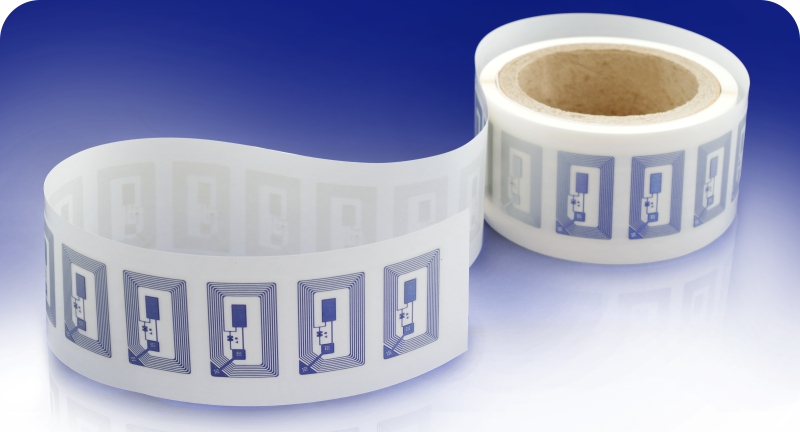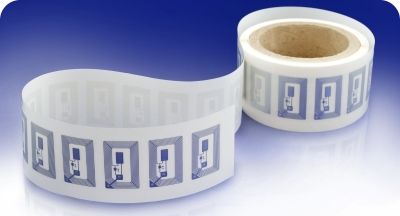Date: 29 Apr 2020
Introducing the second part of our blog article series on Radio Frequency Identification systems, tags and labels:
Types of RFID labels and tags and their difference with barcode labels
 Depending on the functionality and the purpose of RFID labels, they can be divided into different groups. According to their power source, RFID labels are divided into passive and active labels.
Depending on the functionality and the purpose of RFID labels, they can be divided into different groups. According to their power source, RFID labels are divided into passive and active labels.
Passive tags are powered by the reader's antenna. They are the most widely used type of RFID tag, and are cheaper and easier to use. Smart tags are passive RFID tags, which can be adhesive paper labels or foil labels with a built-in antenna and chip (RFID inlay). They combine both technologies - RFID and barcode - in order to guarantee optimal functionality.
They can be printed and encoded with a thermal transfer barcode printer with a built-in RFID module. The labels can also be pre-printed on a flexo machine or via other conventional technology. After the pre-print process, the antenna and chip can be integrated.
Active RFID tags, by contrast, are powered by a built-in battery. The battery can be solar or ordinary, depending on the wishes of the client or the requirements of the application. These labels are used in specific applications, can be read from a greater reading distance and are usually tags. They may also have additional built-in electronics, sensors, communication ports and even a micro processor.
These optional additions are chosen by the customer, according to their RFID application and product purpose. If you have any questions regarding what types of electronics can be built into a tag, please contact our labeling specialists at sales@dilcom.com. We can work together to create a custom solution for your brand.
According to the frequency range and frequency bands, RFID tags are divided into two more categories. They can be high frequency (HF - runs at 13.56 mhz) or ultra high frequency (UHF - runs at 433 and 860-960 MHz). The radio waves, through which RFID technology works, behave differently at different frequencies. Thus, making the right choice between HF and UHF is very important for the functionality of your tags.
RFID labels or barcode labels?
As in most cases, the comparison of two very different technologies cannot give a specific answer to this question. They both have advantages and disadvantages, as you will see in the discussion below. The choice of label identification technology depends on the specifics of the application and the goal to be achieved.
One of the main advantages of RFID technology compared to barcode labels is the ability to read multiple labels simultaneously in a very short amount of time. During the reading, the RFID reader is not required to have direct visual contact with the label. The labelled products can be read even when they are in boxes on pallets or on shelves. This is incredibly valuable especially in applications concerned with the supply chain.
Another advantage of RFID technology is the ability to encode large amounts of digital data into one smart label. The recorded information can be altered after the initial encoding, if any product changes arise. The volume of this information can be many times higher than the amount of data that can be recorded in any 2D barcode.
Manufacturers can use this feature to include information about the origin of products of any additional details about them. They can also contain promotional data and marketing materials.
Smart labels are also now commonly used as a means of access control, and brand and product counterfeit protection. They are perfectly suitable for this application because each RFID label has a unique ID that cannot be copied or modified.
Barcode labels are widely used for general-purpose labeling and product identification in many different industry sectors. RFID tags offer much more technologically advanced labeling capabilities and unique methods for marking products.
In spite of this, they are significantly less used than barcode labels. The main reason for this is their much higher cost. Their price, however, has been on a steady downward trend over the last few years.
A technological disadvantage of RFID technology is the effect of metals and liquids on the reading range of the labels. The energy emitted from RFID readers is reflected by metal surfaces. This creates interference for the antennas built into the RFID tag. When this occurs, the label cannot receive power and transmit the necessary information.
In some cases, liquids have also been found to inhibit RFID energy transfer and communication transmission. However, in recent years, the technology has made certain advancements on these issues. Now, specific RFID tags can find ways to work around metal objects or near water.
For more information on the use of smart tags in different industries, read the third part of our blog series. It looks at the application of RFID labels and tags in various industries.
Check out the first part of our blog article series that discusses topics related to RFID systems.


Post comment